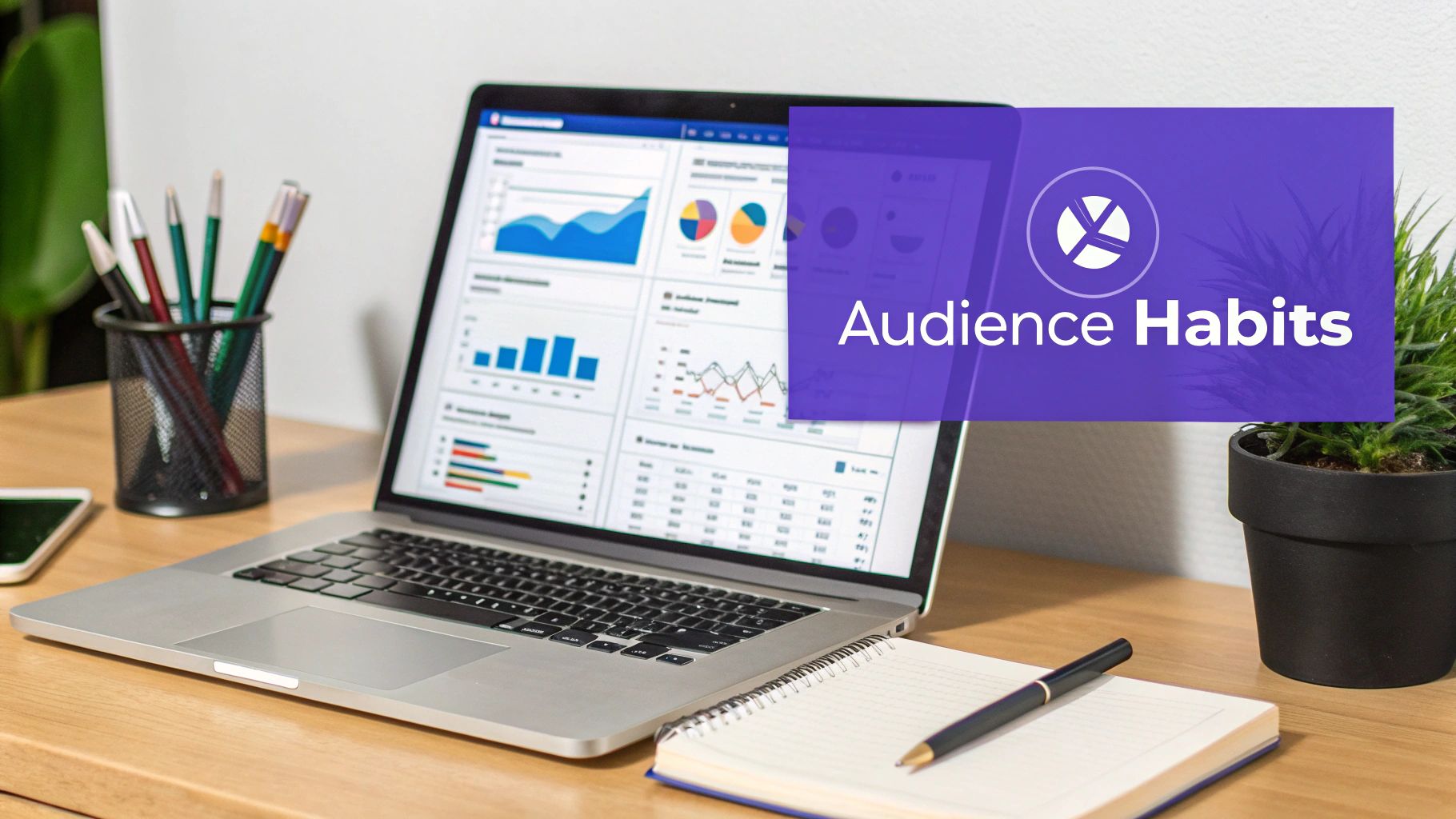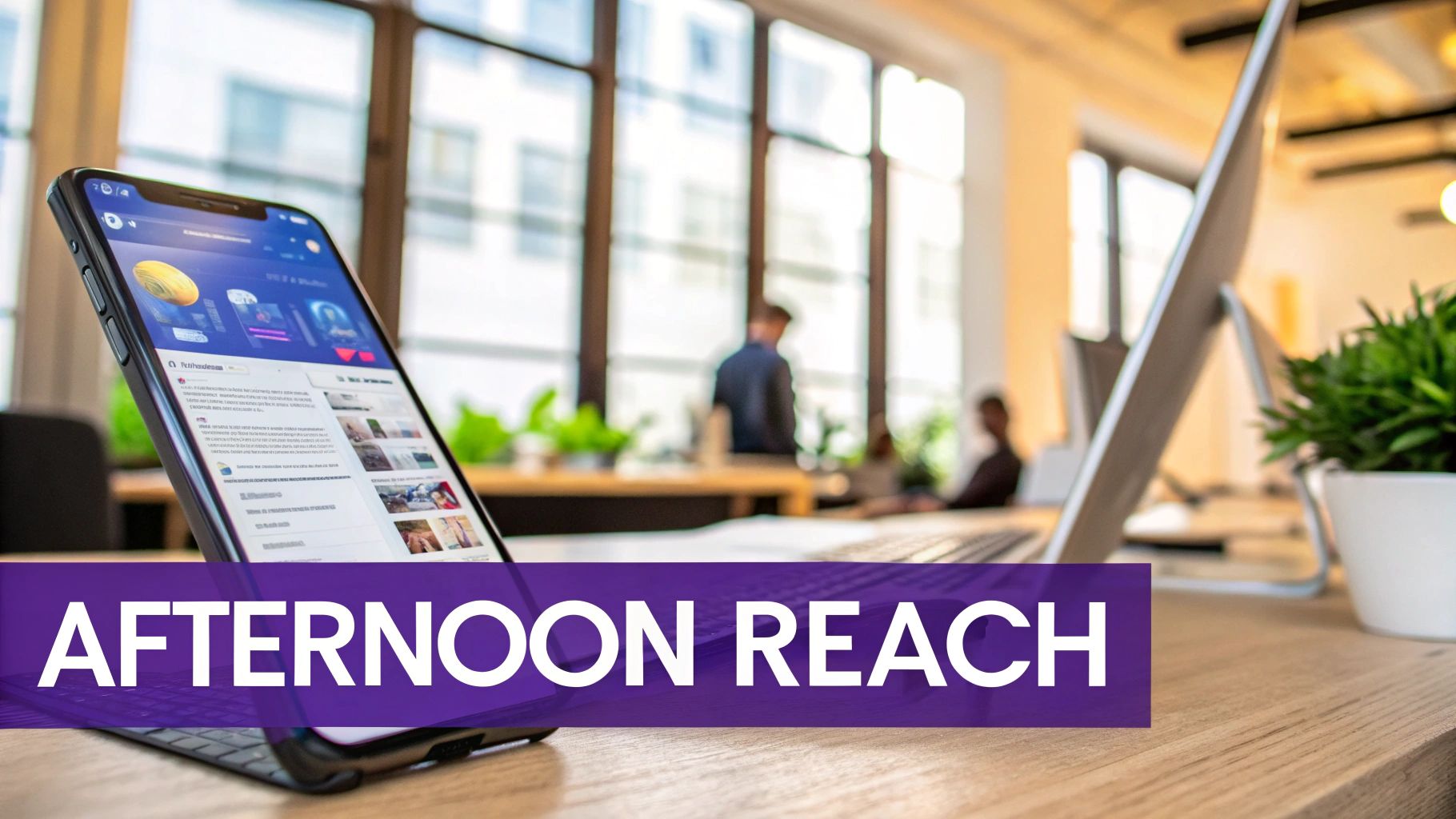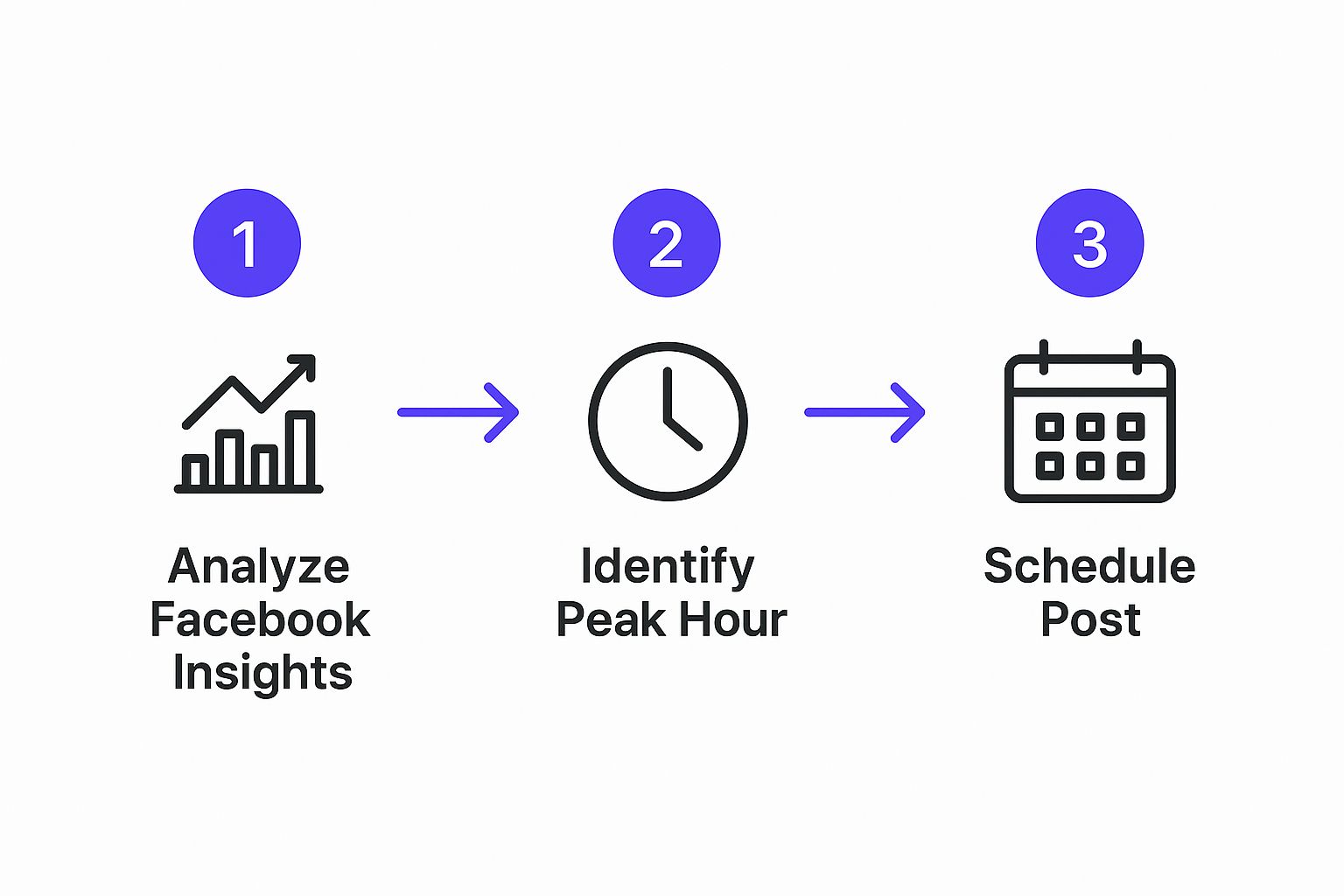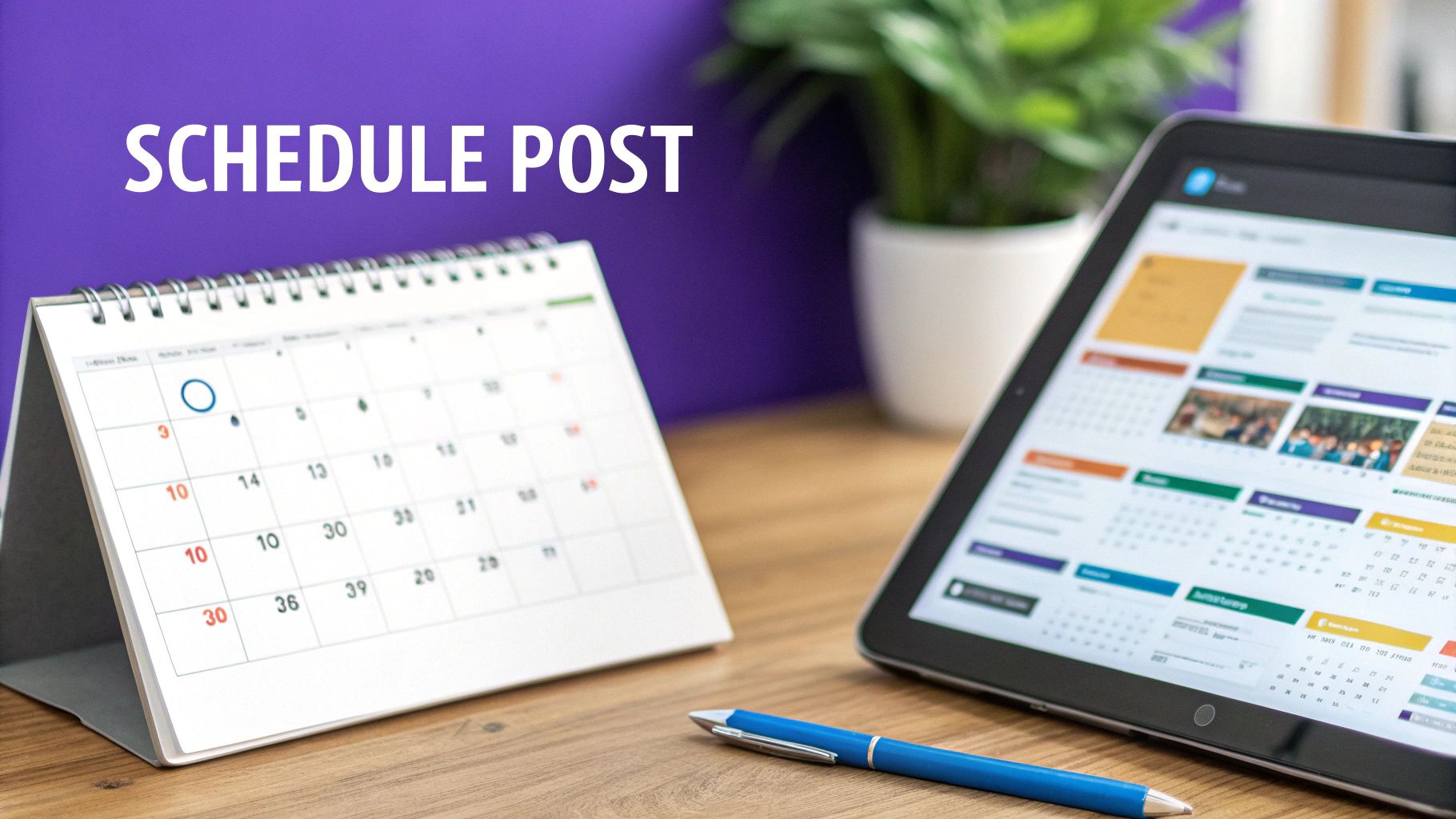When Is the Best Time of Day to Post on Facebook?
Unlock peak engagement by discovering the best time of day to post on Facebook. Learn how to find your brand's unique posting window with our data-driven guide.
Posted by
If you’ve ever wondered when the best time of day to post on Facebook is, you're not alone. After years in the trenches of social media marketing, I can tell you that the general wisdom holds true: early weekday mornings are a goldmine. The data consistently shows that publishing between 7 AM and noon, Monday through Friday, puts your content in front of people as they're just starting their day.
Your Quick Guide to Peak Facebook Posting Times

Let's get straight to what works. You need to know the most effective times to post on Facebook to get the most eyeballs on your content. Based on a mountain of industry data, the verdict is in: early to mid-mornings on weekdays are the prime real estate.
This isn't just a guess; it's a reflection of real human behavior. Think about the morning commute scroll or that first coffee break at the office. That's your window.
We'll start with these widely recognized peak times to give you an immediate starting point. Think of these as reliable benchmarks for your content schedule before we dig into fine-tuning a strategy that's a perfect fit for your audience.
Understanding the General Posting Windows
Treat these general time slots as your strategic launchpad. Multiple studies from social media analytics platforms have all pointed to the same conclusion: Monday through Friday mornings are where the action is.
If you really want to narrow it down, Wednesday from 7 a.m. to 10 a.m. often emerges as the absolute sweet spot for engagement. You can find more data backing this up across various industry reports, including a detailed breakdown from Shopify.
These industry-wide stats are a fantastic baseline, but remember, they are broad averages. While these windows work wonders for a huge number of brands, your specific audience might operate on a completely different schedule. We’ll get into how to uncover your unique peak times later. For now, let’s look at the general playbook.
Key Takeaway: Shifting from random posting to using these widely accepted times is the first real step toward a smarter content strategy. You’re no longer guessing—you’re making decisions based on data.
General Best Times to Post on Facebook by Day (All Times Local)
To make this super practical, here's a table that breaks down the best times to post, day by day. This framework is a great starting point for scheduling your Facebook content, and honestly, the underlying principles can help inform your entire social media calendar.
For a wider view beyond just Facebook, you might also find value in our comprehensive guide on the best times to post on social media.
| Day of the Week | Optimal Posting Window | Peak Engagement Time |
|---|---|---|
| Monday | 8 AM - 1 PM | 11 AM |
| Tuesday | 8 AM - 2 PM | 10 AM - 12 PM |
| Wednesday | 7 AM - 2 PM | 9 AM - 1 PM |
| Thursday | 9 AM - 1 PM | 12 PM |
| Friday | 8 AM - 12 PM | 9 AM - 11 AM |
| Saturday | 9 AM - 11 AM | 10 AM |
| Sunday | 10 AM - 2 PM | 1 PM |
Use this table to build your initial schedule, and then get ready to refine it with your own audience data. That's where the real magic happens.
Why Early Morning Posts Dominate the News Feed
Ever wonder why that post you shared at 7 a.m. took off, while the one you published at noon barely made a ripple? It’s not your imagination. The secret lies in a clever intersection of the Facebook algorithm and plain old human behavior.
When you publish a post in the quiet of the early morning, you're essentially giving it a head start. It gets indexed and processed by the algorithm long before the platform becomes a firehose of new content from everyone else.
This means that by the time most people grab their phones for that first morning scroll, your post is already in line, ready and waiting to be seen. It's facing a tiny fraction of the competition it would encounter at peak times.
Beating the Morning Rush
Think of it like showing up to a popular concert hours before the headliner. You get a fantastic spot right up front while everyone else is still stuck in traffic. A post that goes live at 5 a.m. has a few precious hours to quietly collect its first likes, comments, and shares. This early trickle of engagement is a powerful signal to the algorithm that your content is worth showing to more people.
By the time the masses log on between 8 a.m. and 10 a.m., Facebook’s algorithm has already taken notice of your post's early momentum. It's far more likely to get pushed to the top of their News Feed, creating a snowball effect that boosts your visibility throughout the day.
Now, contrast that with a post published at 9 a.m. It’s immediately thrown into a chaotic, crowded arena. It has to claw for attention against a flood of other posts from brands, your friends, and every group under the sun, all competing for the same eyeballs at the exact same moment.
Capitalizing on User Habits
This whole strategy hinges on a simple truth: it lines up perfectly with how we actually use social media. That first glance at Facebook for the day? It usually happens over a cup of coffee, during the commute, or in those first few minutes of settling in at the office. Your post is there waiting for them, right when they're most open to seeing it.
Time and again, social media studies have highlighted this early-bird advantage. For example, extensive research from Buffer has pointed to times like 5 a.m. on a Monday as being surprisingly effective. As they explain in their social media timing analysis, content posted this early gets crawled and is primed to be served to users the moment they log in.
This predictable pattern—engagement slowly building from the crack of dawn and peaking around midday—makes those pre-work hours a golden window for getting the most reach.
Pro Tip: Don't just "set it and forget it." Even if you schedule a post for 6 a.m., make a point to be around to engage with the first comments that roll in around 8 or 9 a.m. That little bit of interaction can give your post a significant extra nudge from the algorithm.
Let’s look at how this plays out in the real world for a couple of different businesses:
- A local coffee shop: Scheduling a 6 a.m. post about a new latte special puts your shop front-and-center right when people are deciding where to get their caffeine fix on the way to work.
- A B2B software company: Sharing an insightful article at 7 a.m. can catch business professionals as they check their feeds before diving into their workday, framing your brand as a valuable resource from the get-go.
By posting before your audience is even fully awake, you aren’t just sharing content. You're strategically placing it to win the day's attention game before it has even started.
Finding Your Brand's Unique Posting Sweet Spot
Industry benchmarks are a decent place to start, but let's be honest—your audience isn't an "average." The real magic happens when you move past generic data and start digging into the specific times your followers are actually online, scrolling and ready to engage. This is the difference between a good social strategy and a great one.
So, where do you find this goldmine of information? You don't need a fancy third-party tool. The answer is right inside Facebook's own powerhouse: the Meta Business Suite. It has the exact data you need to stop guessing and start building a posting schedule that’s tailored to your community.
It’s a straightforward process, but I can’t stress this enough: this is the single most effective way to figure out the best time of day to post for your specific page. Let’s walk through exactly how to find and make sense of it.
Diving Into Your Facebook Insights
Your first stop is the Insights tab within the Meta Business Suite. Once you're in, look for the Audience section. This is where Facebook gives you a clear, hour-by-hour breakdown of when your followers are most active online.
You'll see a chart where the darker shades of blue represent the times with the highest user activity. This isn’t some industry-wide estimate; it's a direct look at how your audience behaved over the last month.
Here’s a perfect example of what that "Audience Activity" chart looks like.

For this page, it's crystal clear: things start picking up around 9 AM, but the absolute peak of activity hits right at 9 PM.
Translating Data Into Action
Okay, so you have the chart. Now what? Your job is to play detective and look for the patterns. Are there specific days of the week where activity consistently spikes? Do you see a surge around lunchtime, or is your audience full of night owls?
Key Insight: This data is your ground truth. If every benchmark report screams "post at 10 AM on Tuesdays," but your chart shows your audience is lighting up at 8 PM on Thursdays, trust your data. It's a direct line to your community's habits.
Let's imagine how different businesses might use this information:
- A B2C retail brand might see a huge surge every weekday from 7 PM to 10 PM. That tells me their audience is unwinding and browsing after dinner. I'd tell them to schedule their best content—new arrivals, flash sales, engaging videos—right in that window to drive clicks and sales.
- A B2B consulting firm, on the other hand, might see that activity is highest from 11 AM to 2 PM, Tuesday through Thursday. That's the classic "lunch break scroll" for professionals. For them, posting insightful articles, case studies, or quick tips during that time would be a much smarter play.
This is what a real, personalized strategy looks like. You're no longer just shouting into the void. You're strategically placing your content right where your audience will see it.
Once you’ve identified these peak windows, the next logical step is to use a scheduling tool like EndorseFlow. You can load up your posts in advance and have them go out at those perfect times, ensuring you never miss an opportunity—even if your peak time is late at night or first thing in the morning.
How to Put Your Posting Schedule on Autopilot
So, you've done the hard work and figured out your brand’s unique sweet spot for posting. That’s a huge win. But let’s get real for a second. If your data tells you the perfect time to post is 5 a.m. on a Saturday, are you really going to set an alarm for that?
Manually trying to hit these perfect windows, especially when they fall at odd hours, just isn't sustainable. It's a recipe for burnout, and nobody has time for that.
This is exactly where automation tools come in. Think of a scheduler not just as a convenience, but as your secret weapon for building a reliable content engine. It ensures you capitalize on the best time of day to post on Facebook every single time, whether you're in a meeting, on vacation, or fast asleep.
Imagine spending a couple of hours on a Monday afternoon mapping out a full week of killer content, knowing it will all go live at the most impactful moments. This frees you up to focus on the things that actually move the needle—engaging with your audience, digging into the analytics, and dreaming up your next big campaign.
Building Your Automated Content Pipeline
Getting started with automation is way easier than it sounds. The goal is to create a smooth workflow that gets your content from an idea to a published post without you having to babysit it. With a tool like EndorseFlow, you can hook up your Facebook page and start queuing up content in minutes.
This isn't just about plugging in random posts. It's about building a true content pipeline.
- First, connect your page: You’ll need to link your Facebook Business Page to your scheduling platform. It's a quick, one-time setup that gives the tool permission to post for you.
- Next, map out a content calendar: Plan your posts for the upcoming week or even the whole month. I always recommend mixing up the formats—images, videos, links, questions—to keep your feed interesting.
- Finally, schedule for peak times: This is the most important part. Take those prime engagement windows you discovered in your Facebook Insights and plug them into your scheduler. If 8 p.m. on Thursday is when your audience is most active, that’s exactly when your most important post should go live.
To really get this system humming, it helps to learn how to schedule social media posts for real results and make it a repeatable process.
A Quick Tip From The Trenches: Don't just "set it and forget it." I make a point to check in on my automated posts a couple of times a day. Hopping into the comments to answer questions as they roll in is crucial for building a genuine community and shows the algorithm that your content is sparking valuable conversations.
This visual breaks down the simple, data-driven cycle for smart scheduling.

This flow—analyze, identify, and schedule—is the bedrock of any smart, automated Facebook strategy.
Consistency Is the Real Game-Changer
The true magic of automation isn't just saving time; it's the unwavering consistency it provides. The Facebook algorithm absolutely loves pages that post on a regular, predictable schedule.
When you consistently show up with great content when your audience is most likely to see it, you're sending powerful signals that your page is a reliable source of value. This builds incredible momentum over time, leading to much better organic reach.
If you want to dig deeper into making your workflow as efficient as possible, check out our guide on how to https://www.endorseflow.co/blog/automate-social-media-posts and start saving time. Ultimately, automation turns posting from a daily chore into a strategic advantage that works for you 24/7.
Analyzing Performance and Refining Your Strategy

Think of your first posting schedule as your best guess. It’s a great starting point, but the real magic happens when you start treating it like a living strategy—one that you constantly tweak and improve based on real-world data.
The secret to long-term success isn’t finding one "perfect" time and sticking to it forever. It's all about the cycle: post, analyze, adjust, and repeat. This is how you go from good timing to great timing that's perfectly synced with your specific audience.
What Metrics Actually Matter for Timing
To figure out if your timing is on point, you have to look beyond a simple "like" count. You need to dig into the social media engagement metrics that tell the full story.
When you open up your Facebook Insights, zero in on these three core indicators:
- Reach: This is the number of unique people who saw your post. If a post has high reach but barely any engagement, it could mean you caught people when they were just passively scrolling, not when they were ready to interact.
- Engagement Rate: This is your secret weapon. By looking at comments, shares, and reactions relative to your reach, you get a clear picture of how compelling your content was. It's the ultimate test of both your content quality and your timing.
- Click-Through Rate (CTR): For any post that includes a link, this metric is crucial. It shows how many people were motivated enough by your post to actually click. A low CTR might point to a timing problem, a weak call-to-action, or a mismatch between your copy and your audience's interest at that moment.
Getting a handle on this data is much easier when you have the right tools in your corner. If you're looking to upgrade your analytics game, our guide on https://www.endorseflow.co/blog/social-media-analytics-tools is a great place to start.
Expert Insight: Always investigate the outliers. Did a post randomly blow up at 10 p.m. on a Sunday? Don't just write it off. Try posting something similar around that time again. You might have just discovered a hidden engagement sweet spot for your audience.
A Simple Approach to A/B Testing Your Schedule
Once you have some data rolling in, you can start actively testing your posting times. Don't worry, A/B testing sounds more complicated than it is. The core idea is simple: change just one thing—in this case, the time—while keeping the content as similar as possible.
Here's a practical example:
- Create two posts with a very similar message and visual.
- Schedule the first one to go live during one of your current best-performing slots, like Tuesday at 9 a.m.
- Schedule the second one for a new time you want to test, maybe Tuesday at 4 p.m.
After a couple of days, compare the reach and engagement rate for both posts. Was one a clear winner? Run this same test a few more times over the next couple of weeks to see if a consistent pattern emerges.
This kind of methodical testing takes the guesswork out of your strategy. You're no longer just hoping for the best; you're making decisions backed by your own data. By continuously testing and refining, you ensure you're not just posting, but posting with purpose.
Common Questions About Facebook Post Timing
Even with all the data in the world, a few questions always pop up when you're trying to nail down the perfect time to post. Let's tackle some of the most common ones we hear, because getting these details right can really refine your strategy.
Does Posting Time Really Change for B2B vs. B2C?
Yes, and the difference is huge. It all comes down to the daily rhythm of your target audience. You're not just posting to Facebook; you're posting for specific people with specific schedules.
-
If you’re a B2C (Business-to-Consumer) brand: Think about when people are not working. Engagement spikes during commute times (7–9 a.m.), on lunch breaks (12–2 p.m.), and in the evenings after 5 p.m. when everyone is scrolling on the couch. Weekends are often a goldmine for consumer-facing businesses.
-
If you’re a B2B (Business-to-Business) brand: It's pretty much the opposite. Your audience is a captive one during the workday. The sweet spot is often mid-morning (9–11 a.m.) from Monday to Friday, right after they've had their coffee and are catching up on industry news before diving into deep work.
So, How Often Should I Actually Be Posting?
This is the million-dollar question, isn't it? The truth is, there's no magic number. What really matters is consistency, not just flooding people's feeds.
Posting too much leads to burnout (for you and your audience), but posting too little makes it easy to fall off the algorithm's radar.
For most businesses, posting 3 to 5 times per week hits that sweet spot. It's frequent enough to stay top-of-mind without being annoying. The key is to make sure those posts go live during the peak engagement windows you've identified.
I'll always stand by this: One fantastic, perfectly-timed post a day will outperform five mediocre posts thrown at the wall to see what sticks. Quality and timing trump quantity every single time.
Should I Post Reels and Stories at Different Times?
You absolutely should. The way people consume different types of content is totally different, so your timing strategy needs to adjust. Don't just lump them in with your standard feed posts.
-
Facebook Stories: These have a 24-hour shelf life, so timing is everything. You want to post them right before you know your audience will be most active—think late afternoon commutes or evening downtime. This gives you the biggest possible burst of views before they vanish.
-
Facebook Reels: Reels have a much longer potential lifespan since the algorithm can surface them for days or even weeks. But that initial push is critical. By posting a Reel during a high-traffic window, you give it an immediate engagement boost. That initial traction is a powerful signal to Facebook that your content is worth showing to more people.
Ready to stop guessing and start getting your content in front of the right people at the right time? EndorseFlow makes it simple with powerful social media scheduling and effortless testimonial collection all in one place. Start your 14-day free trial today and see what data-driven timing can do for you.